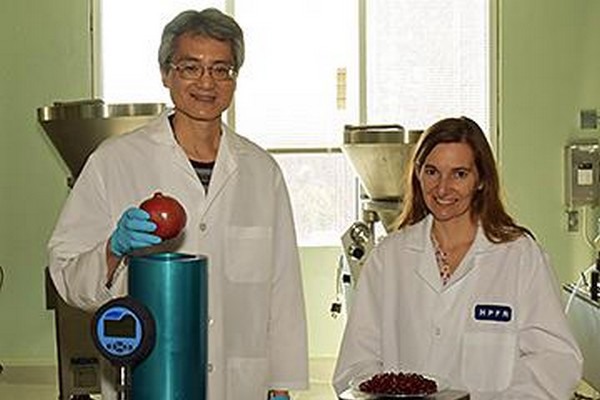In the ever-evolving world of food preservation, a groundbreaking technology known as isochoric freezing is capturing the spotlight, offering the promise of longer-lasting, higher-quality food products.
At the core of isochoric freezing is its distinctive approach to preserving food quality without actually freezing the food. While traditional freezing occurs at a constant pressure (atmospheric pressure), isochoric freezing occurs at a constant volume, resulting in varying pressures according to the freezing temperature. This unique feature offers several advantages in preserving the quality and texture of food products.
 ARS researchers Bor-Sen Chiou and Cristina Bilbao-Sainz test their isochoric freezing technique. Isochoric freezing allows for higher quality storage of fresh foods such as tomatoes, pomegranate arils, and blueberries that are otherwise difficult to preserve with conventional freezing. (Photo courtesy of ARS Healthy Processed Foods Research Unit)
ARS researchers Bor-Sen Chiou and Cristina Bilbao-Sainz test their isochoric freezing technique. Isochoric freezing allows for higher quality storage of fresh foods such as tomatoes, pomegranate arils, and blueberries that are otherwise difficult to preserve with conventional freezing. (Photo courtesy of ARS Healthy Processed Foods Research Unit)
Traditional freezing involves placing food products directly in a freezer. In contrast, isochoric freezing requires the food products to be first enclosed within a rigid chamber filled with an aqueous solution, and this chamber is then placed in a freezer. The aqueous solution plays a critical role in controlling ice formation during the freezing process.
The key principles behind isochoric freezing are both fascinating and effective.
"In isochoric freezing, as the ice starts forming, it does so in a controlled area within the aqueous solution, away from the food product," said ARS research food technologist Cristina Bilbao-Sainz, who works at the Healthy Processed Foods Research Unit in Albany, CA. "The expansion of ice generates pressure inside the closed chamber, which hinders further ice formation. Once the chamber and its contents reach the desired freezing temperature, two distinct sections exist inside the chamber: a frozen ice section and a non-frozen aqueous section. Since the food product resides in the non-frozen section, it is preserved at subfreezing temperatures with no internal ice formation."
This controlled process is the magic behind isochoric freezing. It ensures that food retains its original quality, flavor, and nutritional value, even after prolonged storage.
While isochoric freezing presents significant advantages, it's not without its limitations. Bilbao-Sainz notes that pressure, a crucial component of isochoric freezing, can damage cellular tissues. For solid foods with cellular structures, it's crucial to maintain the preservation temperature above approximately -5°C to avoid the generation of high pressures that can harm the product. Balancing the benefits and constraints of pressure is a key challenge to optimizing the isochoric freezing process.
Bilbao-Sainz sees immense potential for isochoric freezing across various industries. She notes that the fresh and minimally processed food sectors, especially those with short-season and highly perishable items like fruits and vegetables, stand to benefit the most. Additionally, industries dealing with products that do not fare well under conventional freezing methods, such as certain fish products, could find isochoric freezing invaluable. This innovative technology also offers a compelling solution for reducing food waste by significantly extending the shelf life of various products.
"There is great potential for isochoric freezing to revolutionize the food preservation industry," said Bilbao-Sainz. "The freezing could create an expanded availability of fresh produce, better quality fresh and minimally processed fruits and vegetables with extended shelf life, and reduce food waste. This technology also aligns with the industry's growing emphasis on sustainability, quality, and nutritional integrity."
The annual global energy consumption of frozen food storage could be dramatically reduced by isochoric freezing storage by as much as 6.49 billion kWh, with accompanying carbon emission savings of 4.59 billion kg.
Bilbao-Sainz and her team are actively exploring the use of isochoric freezing for the sterilization and pasteurization of liquid foods, such as fruit and vegetable juices and dairy-based products. These efforts represent a significant expansion of the versatile technology's potential applications.
Source: tellus.ars.usda.gov
